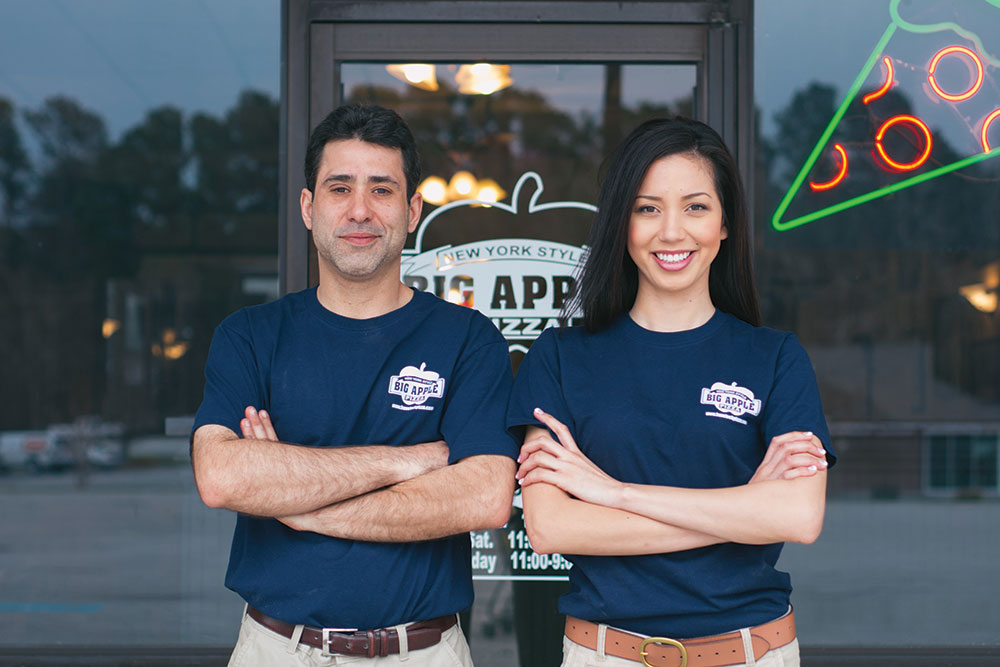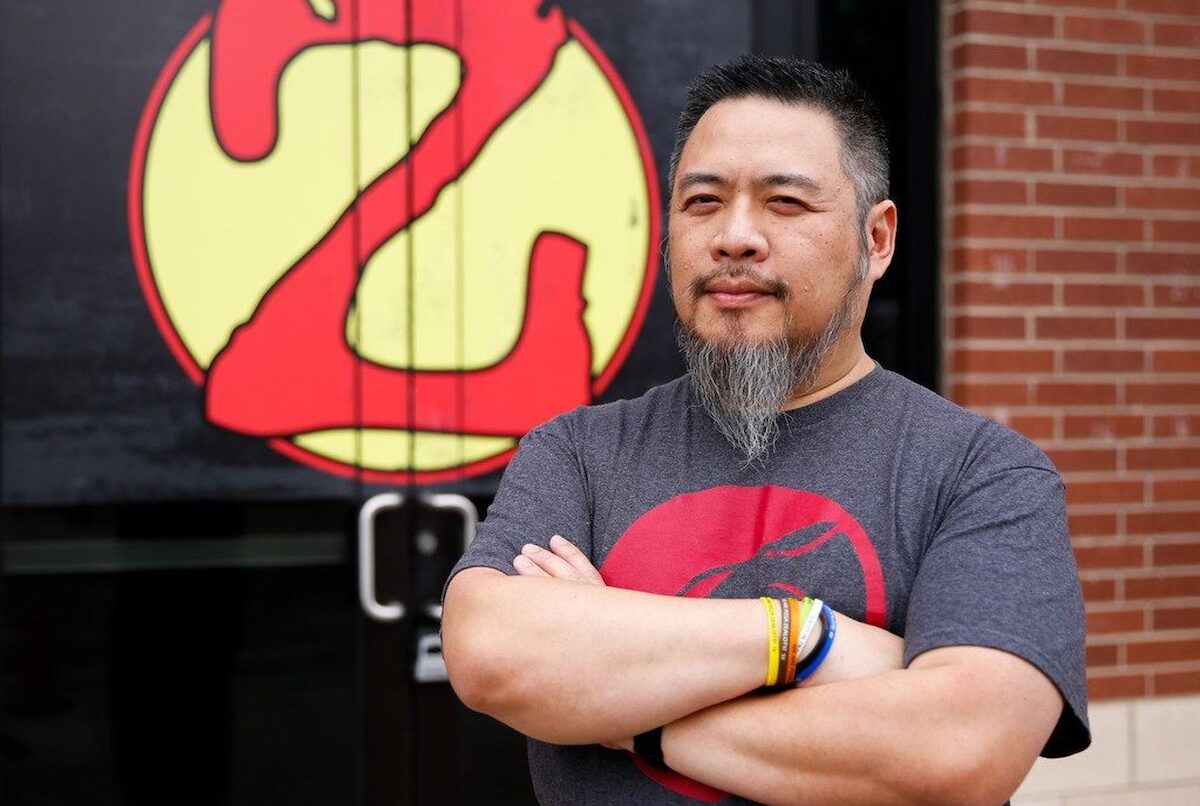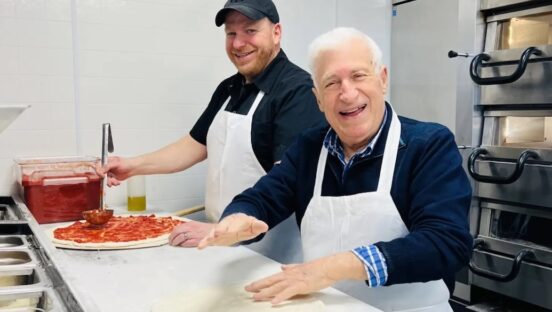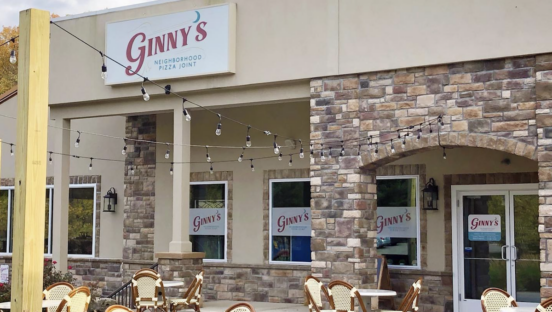A lot of single-unit restaurants have a Facebook or Twitter account. But Big Apple Pizza (havelockpizza.com), a pocket-sized pizzeria in Havelock, North Carolina, stands out as a shining example of a mom-and-pop shop that has fully embraced the digital age, combining the best of traditional neighborhood marketing strategies with high-powered social media to become a pizza making force in its market. From Little League sponsorships to six-second Vine videos, from movie theater ads to check-in specials and a thriving online ordering system, Big Apple Pizza keeps expanding its presence—and that’s no easy task for a 20-year-old restaurant that spans a mere 1,575 square feet.
“When we started, the rule of thumb was location, location, location,” says owner Anthony Rocco. “Now, as the pizza industry has developed and social media has become more popular, it’s more like marketing, location, marketing. This is even truer in the pizza delivery market.”
Faced with stiff competition from major chains, Rocco knew that the old-school ways, although successful, were no longer enough. Fortunately, he discovered a new secret weapon standing right at his shop’s counter: 21-year-old Chantale Ley, who soon went from running Big Apple’s old-fashioned cash register and taking phone orders to managing the entire store. And what Ley lacked in operations experience, she made up for with sheer smarts, a strong work ethic and a natural instinct for marketing.
Separately, Rocco, who’s only 42, and Ley have excelled throughout their young lives. Together, they make an especially formidable team, guiding Big Apple Pizza through a new phase of growth and innovation while preserving the traditions that have made the pizzeria so successful for the past two decades.
Little Shop, Big Menu
Like Ley, Rocco was a youngster when he started in the pizza business. A native of Staten Island, New York, he moved to North Carolina when he was 15. Despite his Italian roots, Rocco didn’t come from a family of pizzaioli; he had to learn the business on his own. “I got my first job in a pizzeria when I was 17, fell in love with it and continued to do it for years,” he recalls. “After getting about five years’ experience, I received an opportunity to open my own place with my cousin in 1993.”
Rocco and his partner opened six more Big Apple locations before splitting in 2005. Rocco held on to the Havelock store, which is not affiliated with any other Big Apples in the United States. Opened in 1994, it’s a tiny space that seats 26 people, tops, and offers citywide delivery. Dine-in and carryout customers place their orders at the counter and chat with the pizza makers while they wait. “Our open kitchen is comprised of one double-stack oven, and three steps over is the cash register, and three more steps over are the sub units,” Ley says. “It’s an extremely tight squeeze. It’s so small that we have to keep our walk-in cooler and freezer outside on the back deck.”
But this little shop does big business. Although Rocco declined to allow his annual sales totals to be published, the figures are impressive and grow every year. The store’s extensive menu plays a major role in its success. Big Apple offers 14 specialty pies, including the Antipasto Pizza (loaded with ham, salami, pepperoni, black and green olives, roasted red peppers, red onions and banana peppers) and the Italian Sunday Pizza (provolone cheese, marinara sauce, chopped meatballs, Italian rope sausage, chunks of baked ziti and more). Pasta dishes abound, along with nearly 20 sub sandwiches and wraps, plus burgers, gyros and wings.
“We try to add menu items every so often to keep the menu new and exciting,” Rocco says. “It started out very basic. Over time, it evolved, with new ideas coming from the customers and the employees. However, we don’t order one single ingredient for one specific item. Most of the new menu items are using ingredients we already have.”
Rocco says the specialty pies “set us apart from other pizzerias and give a better variety. But everything sells extremely well. Our sandwiches are very popular. All in all, I’m proud of everything on our menu.”
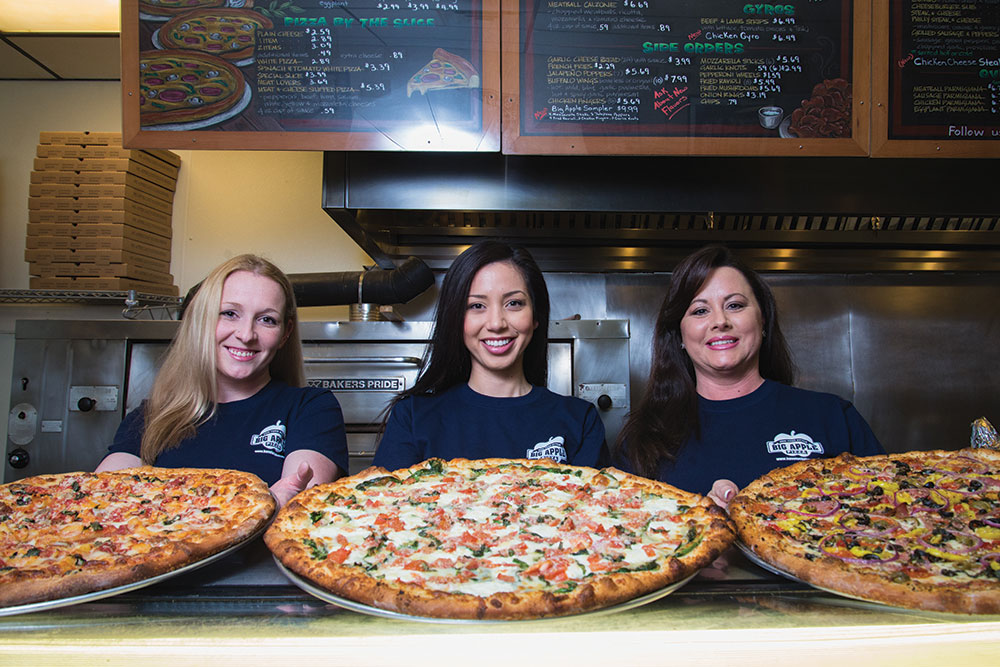 |
|
A self-starter with a natural marketing instinct, Chantale Ley (center), flanked by assistant manager Nicole Bartell (left) and co-owner Tammy Rocco, became Big Apple’s manager at the tender age of 21. |
Mastering Social Media
Ley, a California transplant, was studying for a career in law before a newfound love for pizza making changed her life’s course. “I don’t even know how it happened, to be honest,” she says. “I started out as the counter girl, running the register. I worked hard to get to this point, but that’s probably because I love the place so much that I really couldn’t do any less.”
As Ley was still learning the business, Rocco made her the manager last October, and they soon added a POS system to modernize operations. Although Ley never took a single marketing course in college, she proved to be a natural, and social media became her marketing tool of choice. She grew the store’s Facebook base from about 300 likes to 1,200-plus in a few months’ time and developed a schedule for posting updates. “We try to post something at 9:30 a.m. because most of our lunch customers are sitting in their offices at work, and a lot of them are on Facebook,” Ley says. “We’ll post again at 3:30 p.m. for the dinnertime crowd, and if we’re also running contests, we’ll post something about that between 2 p.m. and 5 p.m. I try to make sure we’re consistent about that.”
A photograph of a tasty-looking pizza or sandwich accompanies nearly every post, and many of the pictures bear the Big Apple logo to reinforce brand recognition. Although most updates have a promotional angle, Ley and her team sweeten the sales messages with humor, including silly rhymes and jokes that reference pop culture, from Geico commercials to Carly Rae Jepsen’s “Call Me Maybe.” When Ley starts running low on ideas, Rocco pitches in. “Sometimes I don’t think I’m funny, but I just go with it,” she says. “If you’re laughing at something, Anthony probably came up with it. But every once in a while, I come up with something clever. I just don’t want it to look like an advertisement. I want to make people laugh. I want it to be fun and trendy and interesting. And I want people to interact with us.”
Ley promotes check-in specials to keep the Big Apple name circulating on Facebook. Any customer who checks in from the pizzeria on his Facebook account gets a freebie of some sort. “Check-in specials get the younger people involved,” she says. “Just show us the check-in on your phone, and we’ll give you free garlic knots or a drink. They’re small items, but people get excited about getting something for free. And if that person has 400 friends on Facebook, that check-in special goes out to those 400 people.”
Ley also shoots short, looping videos on her smartphone using the popular Vine app and posts them on Facebook. “Vine is a newer type of social media that’s very trendy with the younger kids,” she notes. “The videos are only six seconds long, and you can upload them right from your phone to Facebook. It’s easy, and it takes me about a minute to finish one video.”
The videos offer a behind-the-scenes glimpse as Big Apple staffers stretch and spin dough or whip up a Steak & Cheese Sub. Another Vine clip takes viewers through the steps of prepping and baking the Spinach and Tomato White Pie. “I think it’s entertaining to see how everything is made,” Ley says. “The videos are short, so if someone clicks on one and watches it, they have to rewatch it to get the full effect. And it really gets people interested in placing an order.”
Most posts also contain a shortened link—or bit link—that directs users to Big Apple’s website menu or online ordering page. “A bit link is a way to shorten a URL, but it also lets you track how many people clicked on the link,” Ley explains. “I will put a specific link on a specific picture of food or some other post, then go back and see which ones people are clicking on. Then I know what makes for a successful post and what doesn’t work. Even if people didn’t like your status, they may still have clicked on the link. And most of my bit links go straight to our online ordering page to encourage more sales.”
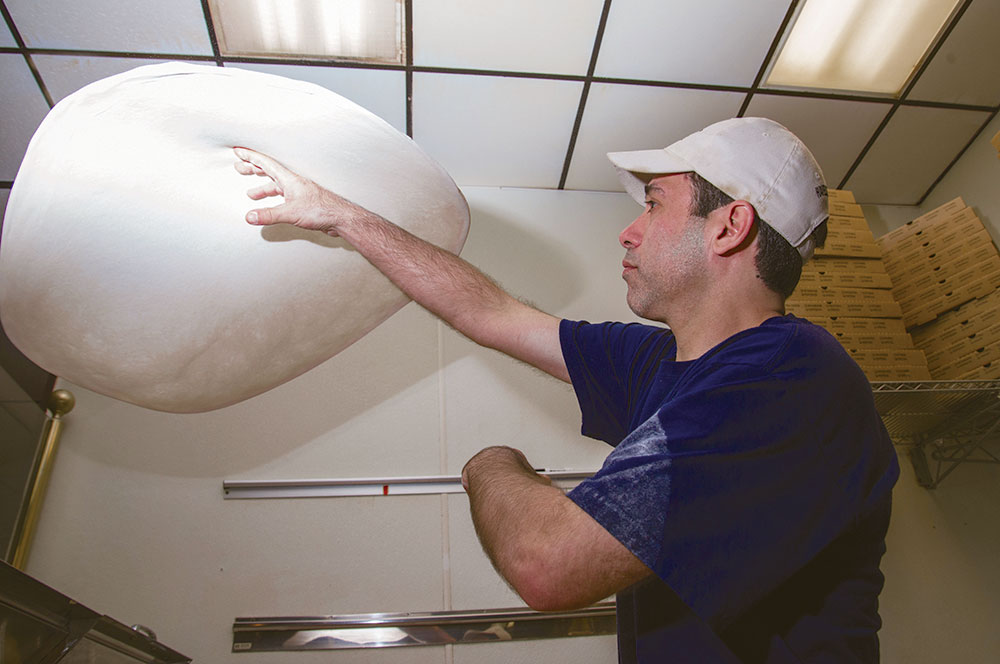 |
|
After 20 years in business, owner Anthony Rocco still finds time to make pizzas nearly every day at Big Apple. |
Boosting Orders
Big Apple Pizza only recently launched its online ordering component, but it had an immediate impact. “The size of our ticket orders are definitely bigger, about 15% to 20% higher than regular phone orders,” Rocco says.
“I cannot express this enough—it is awesome,” Ley says. “We are always slam-packed busy, with very limited space and staff. You can call us three or four times on a Friday, and the phone line will probably be busy. When you get through, you’ll likely get put on hold. This is not intentional by any means—we even have a timer on the phones to make sure no one stays on hold longer than a minute. But a person can only take your order and answer all of your questions about our huge menu so quickly.”
With online ordering, customers can mull over the options and customize orders at their leisure. The result: They tend to place larger orders and spend more money. “When you call us or any national chain, you’re put on hold for a minute or two, and you hear the phones ringing in the background and workers talking,” Ley notes. “You feel rushed, you feel pressured. Instead of asking questions about the menu, you just order a pepperoni pizza. With online ordering, you think, ‘Oh, look at all these specialty pizzas. I’ll order one of those for only $10 more. I’ll get a dessert, too.’”
Ley strives to ensure that roughly 25% of all delivery orders are placed online. “I try to advertise it as much as possible,” she adds. “It’s mentioned on our printed receipts, and we have signs around the shop that say, ‘Online Ordering Now Available.’”
Back to the Old School
Even with all of its digital savvy, old-school marketing methods still drive traffic to Big Apple. “We try to give back to the community as much as possible,” Rocco says. “In a small town, people really appreciate the support.” For starters, Big Apple has long cheered for the local high school football team, which won its third straight state championship last winter. “Every year, when they win state, we paint a Christmas-themed window at our store in their honor,” Rocco says.
The team and coaches return the favor with their business. Big Apple often provides pregame pizzas for the players, and game nights are always busy at the shop. “We usually get slammed right before the game starts and again right after the game,” Ley says. “We also do a lot of contests on Facebook with the team. For example, we’ll give away a free pizza for every touchdown they score.”
Big Apple also sponsors a Little League baseball team that bears the company logo on its uniforms, and fans can’t miss its billboards at Havelock’s baseball and soccer fields. The pizzeria shines on the silver screen, too, thanks to ads that run during previews at the local movie theater located directly across the street from the pizzeria. “We get a lot of people coming over after the movies or even before the movies if they want to sneak food in—they’ll slip a cheese slice into their purses and go to the movies,” Ley says. “So we make sure our ad is always showing in the movie theater—we create a new one every season.”
Perhaps Big Apple’s most effective old-school marketing tool is also its simplest—bottles of water. The pizzeria donates logoed bottles to any group or charity that asks, creating exposure opportunities at nearly every community event. “We gave away 15,000 bottles of water last year to various fundraisers and events,” Rocco says.
Ley recalls spotting Big Apple bottles at a recent 5K charity run. “I was driving to work as the race was finishing,” she says. “Everyone standing at the finish line had Big Apple water—every single one of them. I was honking my horn all the way, it made me so happy.”
One in a Million
Ley isn’t Big Apple’s only happy employee. Once folks join Rocco’s staff, they tend to stick around, and when new employees come on board, the old hands happily teach them the ropes. “I still make pizzas almost on a daily basis, but there are always a couple of experienced pizza makers on staff,” Rocco says. “With some employees having 10-plus years experience with Big Apple and most having five-plus years, there’s always someone on staff who can help out and train new people. Even our drivers rack up years of experience with us, which is rare among pizzerias.”
As for expanding the Big Apple concept, Rocco is open to possibilities. “Over the last few years, we’ve developed our system to the point where it would be easy to expand,” he says. “We’re unofficially talking to people about bringing Big Apple—our product line and system—into their areas as well as helping other pizzerias develop further into a Big Apple location.”
Meanwhile, Ley is just happy to work for a company that she loves. “We have the best employees on the planet,” she says. “They’re one in a million, like family to me, especially my assistant manager, Nicole Bartell, who is absolutely amazing. I could not be successful as a manager without them.”
“Our customers are absolutely awesome, too,” Ley adds. “This is a small town—everybody knows each other. Customers bring you birthday presents. They know what’s going on in your life and care about you. I can walk into Walmart or any grocery store in my Big Apple shirt, and people will shout at me from across the aisle, ‘Hey, Big Apple!’ It’s a great feeling.”
Rick Hynum is PMQ’s editor in chief.
| 5 Keys to Social Media Success |
At 21, Chantale Ley knows the social media generation better than most operators. Here are a few of her tips for success:
|



